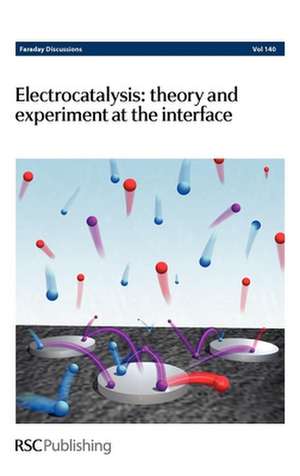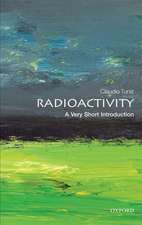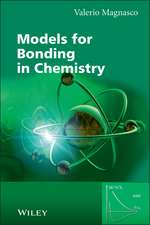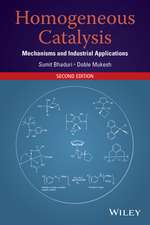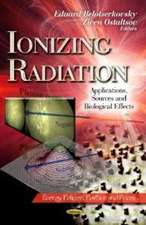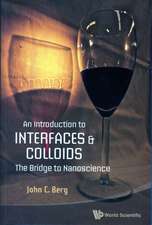Electrocatalysis - Theory and Experiment at the Interface: Faraday Discussions No 140: Faraday Discussions, cartea 140
Autor Royal Society of Chemistryen Limba Engleză Hardback – 30 noi 2008
This unique discussion meeting will bring electrochemists, surface scientists and theoreticians together and foster the development of both in situ spectroscopic methods in electrochemistry and theoretical methods which model the electrocatalytic interface. This unique discussion meeting will bring electrochemists, surface scientists and theoreticians together and foster the development of both in situ spectroscopic methods in electrochemistry and theoretical methods which model the electrocatalytic interface. It will be opened with an introductory lecture by Marc Koper from Leiden University in the Netherlands. Discussion sessions: Structure in Electrocatalysis: from nanoparticles to single crystals Spectroscopy and Electrocatalysis Hydrogen oxidation and oxygen reduction Biological electrocatalysis and alcohols as fuels
Din seria Faraday Discussions
- 14%
 Preț: 1311.83 lei
Preț: 1311.83 lei - 14%
 Preț: 1318.04 lei
Preț: 1318.04 lei - 14%
 Preț: 1329.65 lei
Preț: 1329.65 lei - 14%
 Preț: 1323.05 lei
Preț: 1323.05 lei - 14%
 Preț: 1321.37 lei
Preț: 1321.37 lei - 9%
 Preț: 1180.15 lei
Preț: 1180.15 lei - 14%
 Preț: 1310.15 lei
Preț: 1310.15 lei - 14%
 Preț: 1316.41 lei
Preț: 1316.41 lei - 14%
 Preț: 1306.87 lei
Preț: 1306.87 lei - 14%
 Preț: 1321.37 lei
Preț: 1321.37 lei - 14%
 Preț: 1308.50 lei
Preț: 1308.50 lei - 14%
 Preț: 1328.01 lei
Preț: 1328.01 lei - 14%
 Preț: 1301.86 lei
Preț: 1301.86 lei - 9%
 Preț: 1179.21 lei
Preț: 1179.21 lei - 14%
 Preț: 1319.72 lei
Preț: 1319.72 lei - 14%
 Preț: 1305.19 lei
Preț: 1305.19 lei - 14%
 Preț: 1316.41 lei
Preț: 1316.41 lei - 14%
 Preț: 1321.37 lei
Preț: 1321.37 lei - 14%
 Preț: 1332.98 lei
Preț: 1332.98 lei - 14%
 Preț: 1314.30 lei
Preț: 1314.30 lei - 14%
 Preț: 1306.02 lei
Preț: 1306.02 lei - 14%
 Preț: 1324.68 lei
Preț: 1324.68 lei - 9%
 Preț: 1180.64 lei
Preț: 1180.64 lei - 14%
 Preț: 1326.33 lei
Preț: 1326.33 lei - 14%
 Preț: 1290.29 lei
Preț: 1290.29 lei - 14%
 Preț: 1326.33 lei
Preț: 1326.33 lei - 14%
 Preț: 1310.15 lei
Preț: 1310.15 lei - 14%
 Preț: 1604.94 lei
Preț: 1604.94 lei - 14%
 Preț: 1237.50 lei
Preț: 1237.50 lei - 14%
 Preț: 1232.50 lei
Preț: 1232.50 lei - 14%
 Preț: 1241.29 lei
Preț: 1241.29 lei - 14%
 Preț: 1241.29 lei
Preț: 1241.29 lei - 14%
 Preț: 1242.60 lei
Preț: 1242.60 lei - 14%
 Preț: 1241.29 lei
Preț: 1241.29 lei - 14%
 Preț: 1278.64 lei
Preț: 1278.64 lei - 14%
 Preț: 1288.89 lei
Preț: 1288.89 lei - 14%
 Preț: 1277.65 lei
Preț: 1277.65 lei - 14%
 Preț: 1285.76 lei
Preț: 1285.76 lei - 14%
 Preț: 1279.49 lei
Preț: 1279.49 lei - 14%
 Preț: 1287.25 lei
Preț: 1287.25 lei - 14%
 Preț: 1451.41 lei
Preț: 1451.41 lei - 14%
 Preț: 1291.06 lei
Preț: 1291.06 lei - 14%
 Preț: 1328.01 lei
Preț: 1328.01 lei - 14%
 Preț: 1321.37 lei
Preț: 1321.37 lei - 14%
 Preț: 1318.04 lei
Preț: 1318.04 lei - 14%
 Preț: 1316.41 lei
Preț: 1316.41 lei - 14%
 Preț: 1309.80 lei
Preț: 1309.80 lei - 14%
 Preț: 1318.04 lei
Preț: 1318.04 lei - 14%
 Preț: 1323.05 lei
Preț: 1323.05 lei - 14%
 Preț: 1319.72 lei
Preț: 1319.72 lei
Preț: 1543.93 lei
Preț vechi: 1795.27 lei
-14% Nou
Puncte Express: 2316
Preț estimativ în valută:
295.42€ • 309.28$ • 244.45£
295.42€ • 309.28$ • 244.45£
Carte tipărită la comandă
Livrare economică 05-19 aprilie
Preluare comenzi: 021 569.72.76
Specificații
ISBN-13: 9780854041237
ISBN-10: 0854041230
Pagini: 454
Ilustrații: 1, colour illustrations
Dimensiuni: 158 x 240 x 28 mm
Greutate: 0.8 kg
Editura: Royal Society Of Chemistry
Seria Faraday Discussions
ISBN-10: 0854041230
Pagini: 454
Ilustrații: 1, colour illustrations
Dimensiuni: 158 x 240 x 28 mm
Greutate: 0.8 kg
Editura: Royal Society Of Chemistry
Seria Faraday Discussions
Cuprins
Session 1: Structure in Electrocatalysis: from nanoparticles to single crystals -Nanoparticle catalysts with high energy surfaces and enhanced activity synthesized by electrochemical method -Bridging the gap between nanoparticles and single-crystal surfaces -Dynamics of oxidation of CO adsorbed on Pt(111) in acid solutions: simultaneous second harmonic generation and reflectance spectroscopy studies -Surface structure and electrochemistry of model electrocatalysts Session 2: Spectroscopy and Electrocatalysis -Mechanistic and synthetic approaches to nitrate and oxygen electroreduction -Surface-enhanced Raman spectroscopy for investigating electrocatalytic systems at real reaction temperature -Molecular structure at electrode/electrolyte solution interfaces related to electrocatalysis -Electrocatalysis, heterogeneous catalysis: the level of overlap -Interplay of co-adsorption and partial charge transfer phenomena modeled in SHG and electrochemical experiments with polytungstates on platinum -A comparative in situ electrochemical-NMR investigation of PtRu nanoparticles supported on diverse carbon nonomaterials Session 3: Hydrogen oxidation and oxygen reduction -On the catalysis of the hydrogen oxidation -Hydrogen evolution on nano-particulate transition metal sulfides -Influence of water on elementary reaction steps in electrocatalysis -Oxygen reduction reaction in PEM - fuel cells -Intrinsic kinetic equation for the ORR -Size and composition distribution dynamics of nanoparticle electrocatalysts probed by Anomalous Small Angle X-ray Scattering (ASAXS) Session 4: Biological electrocatalysis and alcohols as fuels -Redox enzymes - are they the most efficient electrocatalysts? -Surface enhanced infrared difference absorption (SEIDA) spectroscopy: probing the functionality of a (membrane) protein on the monolayer level -Mesoscopic transport effects in electrocatalytic processes -Surface structure effects on the electrochemical oxidation of ethanol on platinum single crystal electrodes -Electrocatalytic oxidation of ethanol and acetaldehyde on platinum single crystal surfaces
Notă biografică
The need to develop cleaner/greener methods of both energy production and chemical synthesis has been driving renewed interest in electrocatalysis. Experimental advances in the application of spectroscopic methods such as IR, INS, NMR, and XAS, and structural probes such as STM, AFM, high resolution TEM, and XRD are providing a wealth of data that enable structure/property relationships in electrocatalysis to be investigated. Similarly, developments in theoretical methods (MD simulations, DFT calculations, and Monte Carlo simulations combined with ab initio methodologies) are providing new insights regarding old catalysts and promise to provide direction in the search for new catalysts. The advent of high throughput catalyst preparation methods means that many more electrocatalyst formulations are being screened for an ever-wider variety of reactions. Directing this effort will require the combined efforts of theoretical models and the development of new experimental techniques. FD140 will bring surface scientists and electrochemists together and foster the development of both in situ spectroscopic methods in electrochemistry and the study of single crystal electrode surfaces. Advances in theoretical methodology; to describe the state of the art and to address what is still missing. Development of spectroscopic techniques; moving from studies of model surfaces to more realistic surfaces and in situ investigations. Electrocatalyst discovery; what can be learned from high throughput screening methods and theoretical calculations? Beyond fuel cells; the future of electrocatalysis This unique discussion meeting will bring electrochemists, surface scientists and theoreticians together and foster the development of both in situ spectroscopic methods in electrochemistry and theoretical methods which model the electrocatalytic interface. It will be opened with an introductory lecture by Marc Koper from Leiden University in the Netherlands. Discussion sessions: Structure in Electrocatalysis: from nanoparticles to single crystals Spectroscopy and Electrocatalysis Hydrogen oxidation and oxygen reduction Biological electrocatalysis and alcohols as fuels
Textul de pe ultima copertă
The need to develop cleaner/greener methods of both energy production and chemical synthesis has been driving renewed interest in electrocatalysis. Experimental advances in the application of spectroscopic methods such as IR, INS, NMR, and XAS, and structural probes such as STM, AFM, high resolution TEM, and XRD are providing a wealth of data that enable structure/property relationships in electrocatalysis to be investigated. Similarly, developments in theoretical methods (MD simulations, DFT calculations, and Monte Carlo simulations combined with ab initio methodologies) are providing new insights regarding old catalysts and promise to provide direction in the search for new catalysts. The advent of high throughput catalyst preparation methods means that many more electrocatalyst formulations are being screened for an ever-wider variety of reactions. Directing this effort will require the combined efforts of theoretical models and the development of new experimental techniques. FD140 will bring surface scientists and electrochemists together and foster the development of both in situ spectroscopic methods in electrochemistry and the study of single crystal electrode surfaces. Advances in theoretical methodology; to describe the state of the art and to address what is still missing. Development of spectroscopic techniques; moving from studies of model surfaces to more realistic surfaces and in situ investigations. Electrocatalyst discovery; what can be learned from high throughput screening methods and theoretical calculations? Beyond fuel cells; the future of electrocatalysis
Descriere
Surface scientists and electrochemists discuss the development of both in situ spectroscopic methods in electrochemistry and the study of single crystal electrode surfaces
